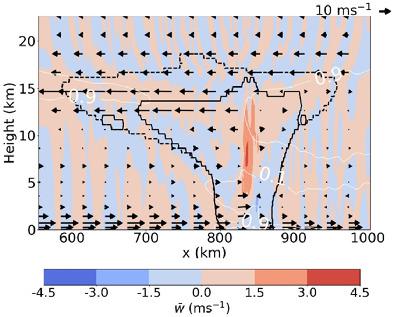当前位置:
X-MOL 学术
›
Q. J. R. Meteorol. Soc.
›
论文详情
Our official English website, www.x-mol.net, welcomes your
feedback! (Note: you will need to create a separate account there.)
Understanding mechanisms for trends in Sahelian squall lines: Roles of thermodynamics and shear
Quarterly Journal of the Royal Meteorological Society ( IF 3.0 ) Pub Date : 2020-12-17 , DOI: 10.1002/qj.3955 Megan E. Bickle 1 , John H. Marsham 2, 3 , Andrew N. Ross 2 , David P. Rowell 4 , Douglas J. Parker 2 , Christopher M. Taylor 5, 6
Quarterly Journal of the Royal Meteorological Society ( IF 3.0 ) Pub Date : 2020-12-17 , DOI: 10.1002/qj.3955 Megan E. Bickle 1 , John H. Marsham 2, 3 , Andrew N. Ross 2 , David P. Rowell 4 , Douglas J. Parker 2 , Christopher M. Taylor 5, 6
Affiliation

|
Squall lines dominate rainfall in the West African Sahel, and evidence suggests they have increased in intensity over recent decades. Stronger wind shear may be a key driver of this trend and could continue to strengthen with climate change. However, global numerical models struggle to capture the role of shear for organised convection, making predictions of changing rainfall intensities in the Sahel uncertain. To investigate the impact of recent and possible future environmental changes, and to isolate thermodynamic effects from shear effects, idealised squall line simulations were initialised with a profile representative of the present day: this profile was then modified using trends from reanalyses and climate projections. Increased shear led to increased storm intensity and rainfall, but the effects of the thermodynamic changes dominated the effects from shear. Simulations initiated with future profiles produced shorter‐lived storms, likely due to increased convective inhibition and the absence of large‐scale convergence or synoptic variability in the idealised model. A theoretical model based on the relative inflow of convectively unstable air and moisture was found to predict bulk characteristics of the storms accurately, including mean rain rates and area‐averaged maximum vertical velocities, explaining the role of shear. However, the model is not a prognostic tool as rainfall is dependent on the storm speed, which remains a free parameter. The study shows the importance of shear to long‐term rainfall trends and highlights the need for climate models to include effects of shear to capture changes in extreme rainfall.
中文翻译:

了解萨赫勒线趋势的机理:热力学和剪切力的作用
线主导着西非萨赫勒地区的降雨,有证据表明,近几十年来,lines线的强度有所增加。更大的风切变可能是这一趋势的主要驱动力,并且可能随着气候变化而继续增强。但是,全球数值模型难以捕捉到剪切作用在有组织对流中的作用,因此无法确定萨赫勒地区降雨强度变化的预测。为了研究近期和未来可能发生的环境变化的影响,并将热力学效应与剪切效应隔离开来,以代表当今的轮廓初始化了理想的qua线模拟:然后使用重新分析和气候预测的趋势来修改此轮廓。剪切力增加导致风暴强度和降雨增加,但是热力学变化的影响主导了剪切的影响。从未来的剖面图开始的模拟产生了寿命较短的风暴,这可能是由于对流抑制作用增加以及理想化模型中没有大规模收敛或天气变化的缘故。发现了基于对流不稳定空气和水分相对流入的理论模型,可以准确预测风暴的总体特征,包括平均降雨率和面积平均最大垂直速度,从而解释了剪切作用。但是,该模型不是预测工具,因为降雨取决于风暴速度,而风暴速度仍然是一个自由参数。这项研究表明了剪力对长期降雨趋势的重要性,并强调了气候模型需要包括剪力的影响以捕捉极端降雨的变化。
更新日期:2020-12-17
中文翻译:

了解萨赫勒线趋势的机理:热力学和剪切力的作用
线主导着西非萨赫勒地区的降雨,有证据表明,近几十年来,lines线的强度有所增加。更大的风切变可能是这一趋势的主要驱动力,并且可能随着气候变化而继续增强。但是,全球数值模型难以捕捉到剪切作用在有组织对流中的作用,因此无法确定萨赫勒地区降雨强度变化的预测。为了研究近期和未来可能发生的环境变化的影响,并将热力学效应与剪切效应隔离开来,以代表当今的轮廓初始化了理想的qua线模拟:然后使用重新分析和气候预测的趋势来修改此轮廓。剪切力增加导致风暴强度和降雨增加,但是热力学变化的影响主导了剪切的影响。从未来的剖面图开始的模拟产生了寿命较短的风暴,这可能是由于对流抑制作用增加以及理想化模型中没有大规模收敛或天气变化的缘故。发现了基于对流不稳定空气和水分相对流入的理论模型,可以准确预测风暴的总体特征,包括平均降雨率和面积平均最大垂直速度,从而解释了剪切作用。但是,该模型不是预测工具,因为降雨取决于风暴速度,而风暴速度仍然是一个自由参数。这项研究表明了剪力对长期降雨趋势的重要性,并强调了气候模型需要包括剪力的影响以捕捉极端降雨的变化。











































 京公网安备 11010802027423号
京公网安备 11010802027423号